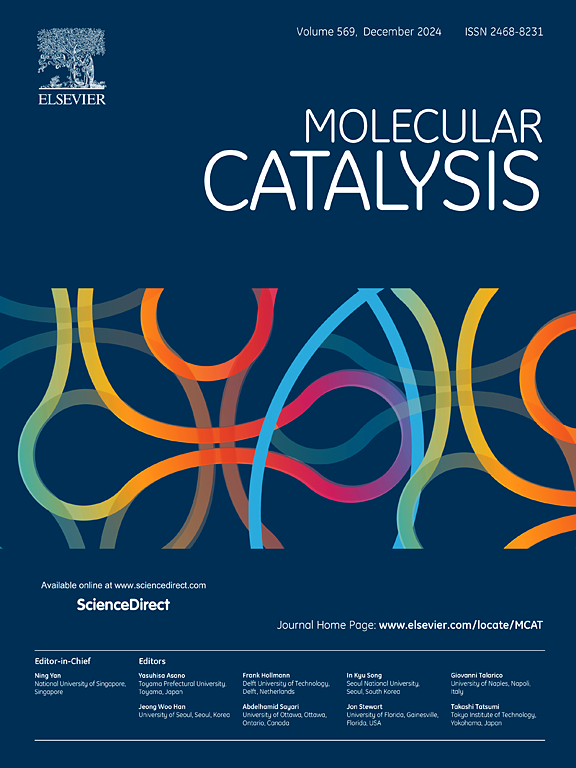以MIL-101衍生碳为气体扩散层的Bi纳米复合材料电沉积CO2电还原增强甲酸生成
IF 3.9
2区 化学
Q2 CHEMISTRY, PHYSICAL
引用次数: 0
摘要
本文制备了一种新型的柔性自支撑气体扩散电极(GDE),该电极包括电沉积Bi纳米复合材料作为催化剂层,MIL-101衍生多孔碳在气体扩散层(GDL)中。与传统的GDE电极制造方法相比,电沉积方法可以避免催化剂层(CL)的繁琐的滴铸过程。电沉积的原位生长方式也可以保证CL与集流器之间的牢固相互作用,从而增强电极的稳定性。同时,MIL-101衍生的多孔碳具有高比面积,有利于CO2在电极上的富集,从而有利于高电流密度的反应。由于其特殊的结构,所合成的催化剂在电催化CO2还原反应(CO2RR)中表现出优异的性能,并增强了甲酸的生成。值得注意的是,在-1.37 V (vs. RHE)下,CO2RR的电流密度为400 mA cm-2,甲酸法拉第效率(FEformate)高达96.5%,甲酸产率达到46.5 mmol cm-2 h-1,优于大多数CO2RR的电催化催化剂。此外,FEformate值在800 mV宽电压窗内保持较高(> 90%),并且催化剂在工业电流密度下也能保持70 h的稳定运行。该工作为设计具有新型结构的gde提供了新的策略,以实现不同电催化的高活性和耐久性。本文章由计算机程序翻译,如有差异,请以英文原文为准。
Electrodeposition of Bi nanocomposite with MIL-101 derived carbon as gas diffusion layer for CO2 electroreduction with enhanced formate generation
Herein, a novel and flexible self-supporting gas diffusion electrode (GDE) was fabricated, which including an electrodeposited Bi nanocomposite as a catalyst layer and MIL-101 derived porous carbon in the gas diffusion layer (GDL). Compared with the conventional fabrication of GDE electrodes, the electrodeposition approach can avoid the tedious drop-casting processes of the catalyst layer (CL). The in situ growth mode by electrodeposition can also ensure the firmly interaction between CL and current collector, thus enhancing the stability of the electrode. Meanwhile, the porous carbon derived from MIL-101 which with a high specific area is conducive for the CO2 enrichment on the electrode, thus facilitate the reaction with high current density. Owe to the special structure, the resultant catalyst showed excellent performance for electrocatalytic CO2 reduction reaction (CO2RR) with enhanced formic acid generation. Notably, at -1.37 V (vs. RHE), a large current density of 400 mA cm-2 and a high formate Faraday efficiency (FEformate) of 96.5 % were achieved, and the yield of formic acid reached 46.5 mmol cm-2 h-1, which is superior to most electrocatalytic catalysts for CO2RR. In addition, the FEformate value remained high (>90 %) over a wide voltage window of 800 mV, and the catalyst also maintained stable operation at industrial current density for 70 h. This work provides a new strategy for the design of GDEs with novel structure to achieve high activity and durability for different electrocatalysis.
求助全文
通过发布文献求助,成功后即可免费获取论文全文。
去求助
来源期刊

Molecular Catalysis
Chemical Engineering-Process Chemistry and Technology
CiteScore
6.90
自引率
10.90%
发文量
700
审稿时长
40 days
期刊介绍:
Molecular Catalysis publishes full papers that are original, rigorous, and scholarly contributions examining the molecular and atomic aspects of catalytic activation and reaction mechanisms. The fields covered are:
Heterogeneous catalysis including immobilized molecular catalysts
Homogeneous catalysis including organocatalysis, organometallic catalysis and biocatalysis
Photo- and electrochemistry
Theoretical aspects of catalysis analyzed by computational methods
 求助内容:
求助内容: 应助结果提醒方式:
应助结果提醒方式:


